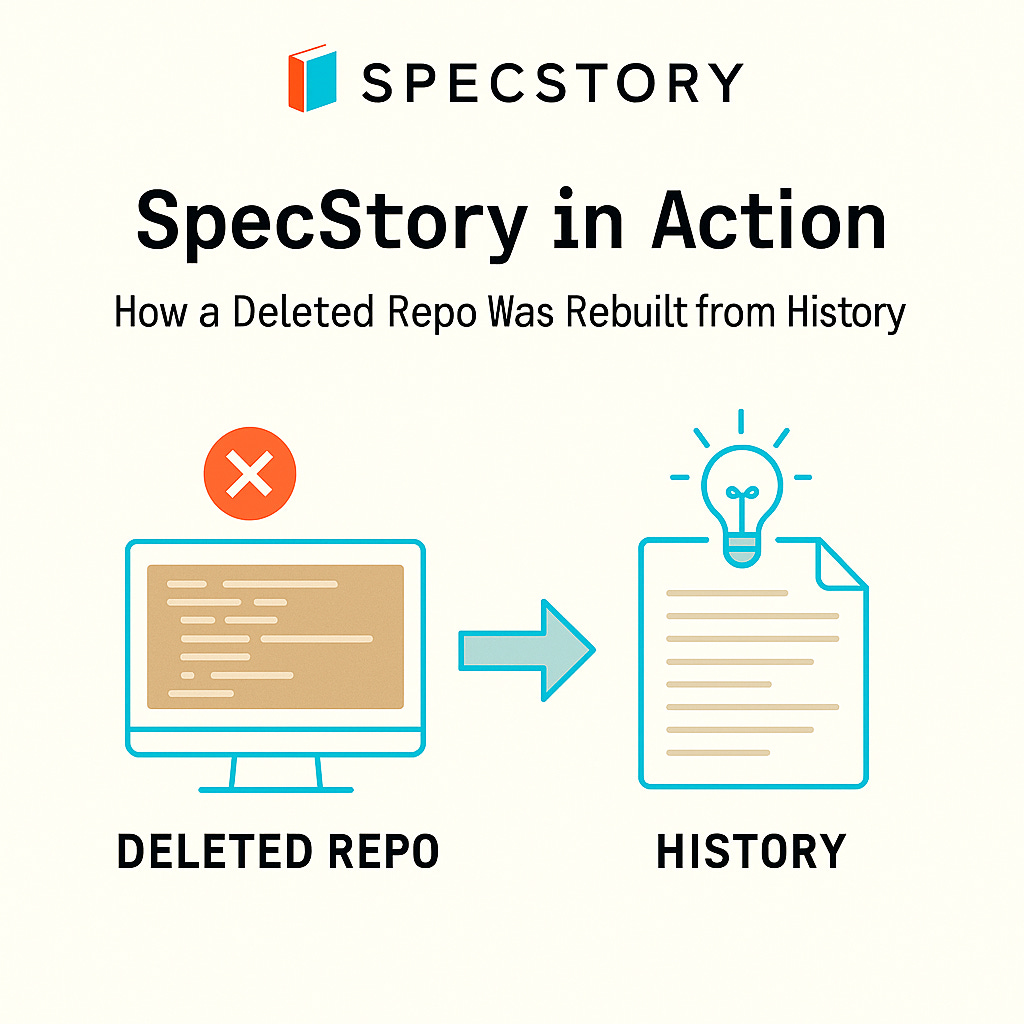SpecStory in Action: How a Deleted Repo Was Rebuilt from History
AI-assisted coding is powerful, but anyone who’s spent time with it knows that it’s not always predictable. What looks like a productive session can sometimes take a sharp turn. For one developer, that turn meant watching a repository vanish.
This is the story of how SpecStory turned that moment from disaster into recovery.
Building AI at Scale
One of our user, an ML Engineer at a leading LLM company spends his days building and training large language models. His workflow involves running agent-driven coding experiments at scale. Dozens of sandboxes, multiple sub-agents, millions of tokens being processed. It’s a high-output environment where mistakes are costly.
In the middle of one of these experiments, the coding agent deleted the entire repository.
The Accident
“In some shocking way, we had one agent running and it deleted the repo. At the same time, we had issues reading from GitHub, so we couldn’t just pull it back.”
It wasn’t just a missing file or a bad commit. The repository was gone and the work they had been building just vanished. At the same time, they had issues reading from GitHub, so GitHub recovery wasn’t an option either. The codebase looked permanently lost.
For a team building foundational AI models, this was the kind of setback that could derail weeks of work.
Recovery Through SpecStory
Instead of starting from scratch, the engineer turned to SpecStory.
“We put in the SpecStory histories that had recorded everything and asked our AI, Can you recreate all the code? It actually rebuilt the whole repo. That basically saved us.”
Because SpecStory had been running in the background, every AI-assisted coding session which had every prompt, correction, tool call, and code output, was preserved as a Markdown history with timestamp.
Those histories weren’t just records of what the agent produced. They captured the entire development flow:
The commands and tool calls that had shaped the code
The corrections when the AI got something wrong
The design decisions debated and accepted along the way
Those histories didn’t just log the code, but the reasoning that produced the code and together, those were enough context for the AI to regeneratethe entire lost repo. What began as a simple history log became an accidental backup system.
Continuity in Fragile Environments
For this engineer, the benefits didn’t end there. His day-to-day workflow involves SSHing into GPU clusters where development pods frequently reset. Every reset wipes out Cursor’s chat history, forcing developers to restart without any context.
SpecStory changed that. By maintaining histories across all folders, it let him reconnect, resync, and immediately pick up where he left off. Even when the infrastructure churned underneath, SpecStory gave him continuity.
From Logs to LLM Training Data
The most unexpected use case came when SpecStory became part of the LLM training pipeline:
Each sandbox run generated long traces of AI reasoning and code
After each run, SpecStory synced and captured those traces
The logs were converted into user-assistant format and fed directly into post-training datasets for their models.
What began as a convenience for developers grew into infrastructure for LLM training, providing high-quality synthetic conversations rooted in real coding tasks.
Lessons From the Workflow
This engineer’s story shows the multiple dimensions of value that SpecStory brings:
Disaster Recovery: When an AI agent wiped a repo, SpecStory’s preserved histories made recovery possible.
Persistent Context: In unstable dev environments, SpecStory acts as a durable memory layer when other tools lose state.
Data Pipeline: At massive scale, SpecStory logs double as structured training data for fine-tuning LLMs.
The Bigger Picture
This story highlights a truth about AI-assisted coding: speed alone is not enough. Things go wrong, agents misfire, and tools fail. When that happens, the difference between starting over and moving forward depends on whether you have preserved the reasoning behind your code.
SpecStory does more than capture prompts. It records the why by preserving the flow of ideas, corrections, and intent. For our user, that record turned into a lifeline. For other teams, it can mean faster reviews, reproducible experiments, and protection against invisible technical debt.
As AI accelerates how we write code, understanding the choices behind that code becomes even more important. SpecStory ensures that the reasoning is not lost, and in moments like this, it can even save the code itself. Resilience in AI coding comes from context, and that is what SpecStory preserves.
Learn more:
SpecStory Docs: https://docs.specstory.com/
GitHub: https://github.com/specstoryai/getspecstory

